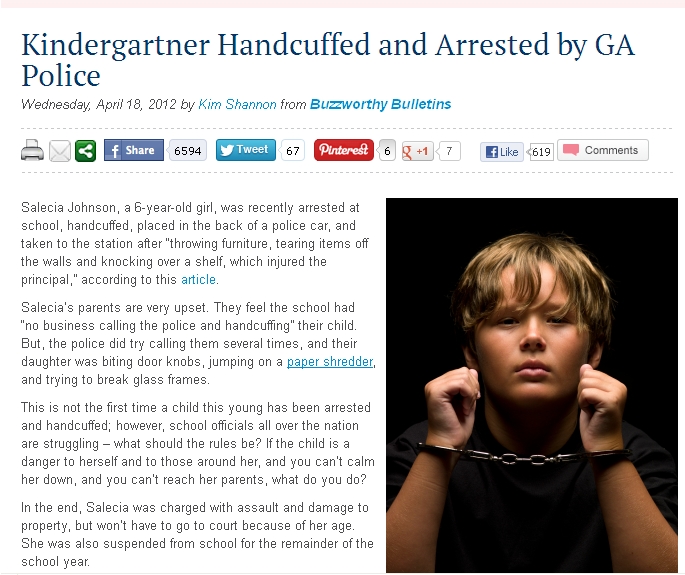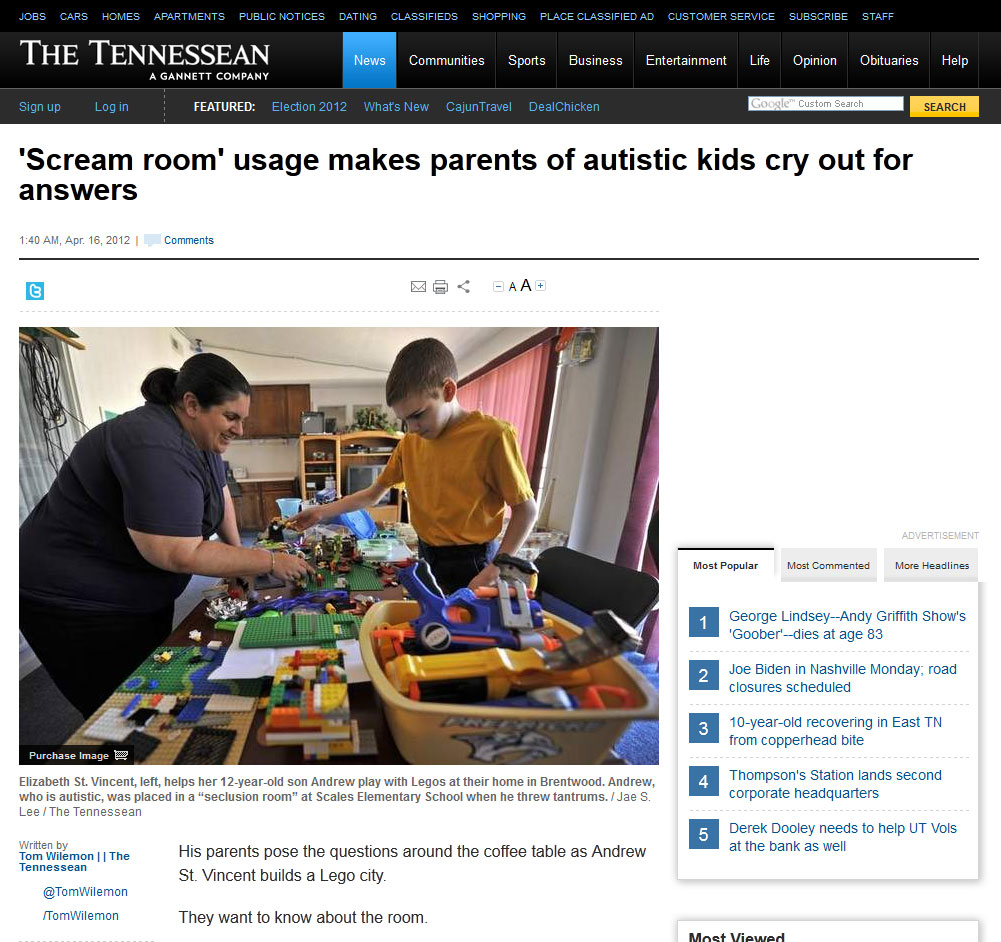Blog & Newsroom
U.S. autism estimates rise by 30 percent for kids
Researchers say increase could be due to better diagnosis of the developmental disorder
(HealthDay News) — One in 68 American children is now diagnosed with autism or a related disorder, federal health officials reported Thursday.
That’s a 30 percent increase from just two years ago when the estimate was one in 88 children, according to a new report from the U.S. Centers for Disease Control and Prevention.
“The number of children identified with autism continues to rise,” said Coleen Boyle, director of the CDC‘s National Center on Birth Defects and Developmental Disabilities.
The continuing increase in the percentage of kids diagnosed with autism could be due to better detection of the developmental disorder, Boyle said, but also might reflect an actual increase in autism.
“It could be a combination of better recognition and increased prevalence,” she said. “Our system tells us what’s going on. It only gives us clues about the why.”
The new statistics also continue to show that autism spectrum disorder is five times more common among boys than girls. And they reflect an increase in the percentage of children being diagnosed with high-functioning autism, the CDC said.
People with an autism spectrum disorder display impaired social and communication skills. Symptoms, which can range from mild to severe, usually become apparent in the first three years of life. The developmental disorder is linked to abnormal biology and chemistry in the brain, according to the U.S. National Institutes of Health.
The agency bases its estimates on reports from 11 communities that participate in its Autismand Developmental Disabilities Monitoring Network. The newest estimate is based on data from 2010.
Estimates of autism among 8-year-olds have more than doubled since the CDC network’s first report in 2007, which calculated that about 1 in 150 children had the disorder based on 2002 data.
The continuing rise of autism highlights the need for more funding for research into the causes of autism and for support and treatment of kids diagnosed with the disorder, said Michael Rosanoff, associate director of research and scientific review at Autism Speaks.
“We really need to double down on our research into the environmental factors that work in some complex way with a child’s genetics to increase the risk of autism,” he said.
There also needs to be continued emphasis on earlier diagnosis of autism, added Dr. Melissa Nishawala, an assistant professor of child and adolescent psychiatry at the NYU School of Medicine and medical director of the Autism Spectrum Disorders Clinical and Research Program.
The new CDC study reports that most children are diagnosed with autism spectrum disorder after age 4, even though autism can be diagnosed as early as age 2.
“We need to push the frontier of diagnosis down to the earliest ages we can,” Nishawala said. “The earlier we intervene, the more we can do to help nudge those brain pathways closer and closer to normal.”
Autism experts believe the increase reported by the CDC is more likely due to improved detection of the disorder, particularly among children at the higher-functioning end of the autism spectrum.
For example, almost half of children identified with autism spectrum disorder in the new study have average or above average intellectual ability, compared to one-third of children a decade ago.
“We are looking much more carefully, and we are getting better at finding kids at both ends of the spectrum, in particular the higher end of the spectrum,” Nishawala said.
At the same time, the experts believe there are likely even more kids with autism than reported, given possible flaws in the CDC’s surveillance system.
“We feel the way the CDC measures autism misses cases and is under-representing it,” Rosanoff said. “This new number doesn’t surprise us, but we feel it still may not be an accurate reflection of the true public health challenge.”
The CDC network tallies cases that come to the attention of physicians or educators, which then are verified through a comprehensive evaluation and a review of school and medical records. But if the case doesn’t attract attention, or if records aren’t available to substantiate the diagnosis of autism, then the network will overlook that case, Rosanoff said.
For example, autism rates vary widely from state to state, ranging from one in 175 children inAlabama to one in 45 children in New Jersey — an indication that some states are doing a better job of detecting and tracking autism. So, the total estimate could be skewed, Rosanoff said.
“All of the variation in prevalence between sites is due to the quality of records between sites,” he said. “Those sites with better records have higher prevalence. In places where detection isn’t as good, you’re going to have a lower number.”
These discrepancies also could explain why white children are much more likely to be diagnosed with autism, Nishawala said.
The new CDC report found that white children were approximately 30 percent more likely to be identified with autism than black children and almost 50 percent more likely than Hispanic children.
The CDC report was published in the March 28 issue of the agency’s Morbidity and Mortality Weekly Report.
On Wednesday, researchers reporting in the New England Journal of Medicine said children with autism show key “patches of disorganization” in the outer layers of the brain. The researchers said this offers more evidence that the developmental disorder begins in the womb.
Researchers have managed to find a few hundred genes that are linked to autism risk. And although there is no definite environmental culprit, studies have tied certain factors during pregnancy to an increased risk, including exposure to high levels of air pollution, low intake of the B vitamin folate and viral infections.
More information
For more on the Autism and Developmental Disabilities Monitoring Network, visit the CDC.
SOURCES: Coleen Boyle, director, U.S. Center for Disease Control and Prevention‘s National Center on Birth Defects and Developmental Disabilities; Melissa Nishawala, M.D., assistant professor of child and adolescent psychiatry, NYU School of Medicine, and medical director of the Autism Spectrum Disorders Clinical and Research Program; Michael Rosanoff, associate director of research, Autism Speaks; March 28, 2014, CDC’s Morbidity and Mortality Weekly Report
Lawmakers push to end ‘scream rooms’ for punishing students
WASHINGTON – When a high school teen acted up in an Indiana classroom a few years ago, his teachers sent him to an isolated room, where he was left unmonitored for hours. He wasn’t allowed to leave, for any reason, and was forced to urinate on the floor. As punishment, he was dragged to that exact same room the following day where he screamed, pleaded and banged on the door for someone to let him out.
When no one came, he tried to hang himself.
The 2011 case is just one example of how children and teens have been isolated in what are known as “scream rooms,” as a means of both punishment and regaining control — a practice that has been called barbaric and abusive, yet is still being used in several states. The use of scream rooms and other forms of restraint were highlighted in a recent Senate report; individual case studies, which did not identify the students, were shared with FoxNews.com.
The incidents detail how students — sometimes as young as 5 years old — are being locked in the padded cell-like chambers as small as four-feet-by-four-feet. And they underscore the frustrating recourse parents are left with if and when they are notified of their children’s treatment. Under current law, parents have few options, but some lawmakers are trying to change that.
Last year, more than 66,000 cases were documented where children were thrown into scream rooms or otherwise restrained, in both public and private schools.
In Connecticut alone, there were more than 30,000 instances of teachers and school officials putting students in scream rooms and physically restraining them. Forty percent of the children who were restrained or secluded had autism. A “disproportionate” number — 53.1 percent — were either black or Latino students. Just 25 percent of the state’s overall population is black or Latino, according to Census figures.
Sen. Tom Harkin, D-Iowa, along with Sen. Chris Murphy, D-Conn., now want to change how students are treated by educators and are pushing for more transparency in the discipline process. They are among a group of Washington lawmakers who are pushing legislation that would end the use of these scream rooms, described as “seclusion,” and regulate the use of restraints by creating national standards.
The report defines “seclusion” as locking a child in a room without supervision of an adult; “restraints” are procedures used to physically limit the movement of a child, which have included holding them down, handcuffing them to chairs and, in one specialized school, using electric shock.
“There is no evidence that physically restraining or putting children in unsupervised seclusion in the K-12 school system provides any educational or therapeutic benefit to a child,” Harkin, chairman of the Senate Health, Education, Labor and Pensions Committee, told FoxNews.com in a written statement. “In fact, use of either seclusion or restraints in non-emergency situations poses significant physical and psychological danger to students.”
In Connecticut, more than 70 percent of reported seclusions lasted less than 20 minutes; however, 119 seclusions lasted more than two hours. Seventy-eight percent of the 119 were described as emergency seclusions.
Some incidents of children being restrained are just as alarming as the use of scream rooms.
Last August in Arizona, a teacher used duct tape to restrain a second-grader in her chair because she was sharpening her pencil too much. And in Kentucky, school officials restrained a 9-year-old autistic boy in a duffle bag as punishment. The child’s mother watched in horror while a teacher’s aide stood silently by and did nothing as the boy struggled to get out.
How to handle unruly students has been a thorny topic for the nation’s education system. Factoring in special-needs students or those with behavioral or developmental challenges has complicated the issue more in recent years. Slashes to state budgets have stripped schools of the funding needed to train teachers and school administrators on dealing with outbursts or problems with students.
Harkin’s Keeping All Students Safe Act prohibits the use of seclusion in locked, unattended rooms. It allows for physical restraints only in emergency situations, and only if it does not inhibit a student’s primary means of communication.
Among other provisions, the act requires state educational agencies to establish policies and procedures to prevent the need for emergency use of restraints. It also requires schools to notify parents within 24 hours that a restraint has been used with their child, to conduct a debriefing with parents and staff after a restraint is used and plan for alternative methods that don’t involve the use of restraints with students in the future.
The legislation, which has the support of more than 200 local, state and national organizations such as United Cerebral Palsy and the National Disability Rights Network, would also establish a state grant program for teacher and school personnel training.
But not everyone is sold.
Lobbyists for school administrators have long opposed efforts by Washington lawmakers to establish a clear set of federal guidelines on how to discipline students. They argue that schools — and not the government — should be in charge.
Thomas Gentzel, executive director for the National School Boards Association, and Daniel Domenech, director of the School Superintendents Association, agree with Harkin that the routine use of restraint and seclusion is “indeed inappropriate” but say the legislation is another example of federal overreach. They argue that it “fails to recognize the need for local school personnel to make decisions based on their onsite, real-time assessment of the situation.”
“Of equal importance, we’re also concerned that the bill would allow parents to go to court without first exercising administrative procedures afforded to them under the current Individuals with Disabilities Act,” Gentzel and Domenech said in a joint statement sent to FoxNews.com. “This bypass encourages litigation and diminishes congressional intent that parents and school districts collaborate to address student special needs. We’re also concerned that the federal court system does not have the capacity to take on these additional cases.”
Six middle school students charged with assault after attack on Virginia bus driver
Six middle school students in Richmond, Va., were suspended after they allegedly attacked their school bus driver. WWBT’s Ashley Monfort reports.
Six students who allegedly assaulted a Richmond, Va., middle school bus driver Tuesday have been arrested and charged, according to the Richmond Police Department.
Richmond City school administrators said the group of students attacked a bus driver on the way to Albert Hill Middle School at approximately 7:30 a.m. Tuesday morning. The alleged assault left the 55-year-old male bus driver with serious face and head injuries, according to NBC12, a station in Richmond.
According to the police report, the alleged attack forced the driver to stop the vehicle and call the police.
“It’s a dangerous position to be in,” bus monitor Hilda Davis told NBC12. “To be attacked like that is a terrible thing to anybody. I feel all these drivers’ pain. You know, it’s a risk and somebody needs to be held accountable. I don’t like this at all.”
The mother of one of the alleged attackers told Richmond’s CBS6 station that the incident began when students on the bus threw crayons at the bus driver. She claims that the driver became agitated and started hitting her son, which triggered the assault.
Police have not specified a motive for the alleged attack.
Richmond Public Schools spokeswoman Felicia Cosby said school officials are continuing to investigate the attack in cooperation with local police.
“We are taking this matter seriously and are working expeditiously with the Richmond Police Department to conduct a full investigation,” Cosby told CBS6. “Once we complete our investigation, appropriate disciplinary action will be taken. The safety and security of both our students and staff are paramount to our mission of promoting student achievement. The alleged misconduct will not be tolerated and those who exhibit such conduct will meet swift and appropriate discipline.”
Kindergartner Handcuffed and Arrested by GA Police
Kindergartner Handcuffed and Arrested by GA Police
Salecia Johnson, a 6-year-old girl, was recently arrested at school, handcuffed, placed in the back of a police car, and taken to the station after “throwing furniture, tearing items off the walls and knocking over a shelf, which injured the principal,” according to this article.
Salecia’s parents are very upset. They feel the school had “no business calling the police and handcuffing” their child. But, the police did try calling them several times, and their daughter was biting door knobs, jumping on a paper shredder, and trying to break glass frames.
This is not the first time a child this young has been arrested and handcuffed; however, school officials all over the nation are struggling – what should the rules be? If the child is a danger to herself and to those around her, and you can’t calm her down, and you can’t reach her parents, what do you do?
In the end, Salecia was charged with assault and damage to property, but won’t have to go to court because of her age. She was also suspended from school for the remainder of the school year.
Salecia’s mother said, “She has mood swings some days, which all of us have mood swings some days. I guess that was just one of her bad days.”
I have a few things to say about this.
First off – and, honestly, no offense to these parents – but, I’m sorry; you guess this was “just one of her bad days”? That is seriously what you told the reporters? I know the bigger issue here is whether or not the police should be able to handcuff children this young. But for some reason, my mind hasn’t even had a chance to consider that part.
I’m still reeling over the fact that a 6-year-old can cause this much damage and upset. I wonder if the other children in her kindergarten class were injured or affected. I’m staggering over her parent’s reaction. I’d probably be livid if my daughter was handcuffed and taken to the station too (Can you imagine how scary that must have been for her?). But I’d also be livid at my daughter for such a horrible display of behavior! And I have to think that this could not have been a behavior shocker for her parents; and if that is the case, why isn’t this child seeing someone professional!?
And, I’d like to think that if I ever find myself in this mother’s position, I’d tell the press, “I’m sorry. My daughter apparently has some serious issues needing immediate attention. Please find it in your heart to forgive her actions, remember her age, and stand by me – and any other families out there with troubled children – as I embark on what I’m sure will be a long journey for our family. I just want my daughter to get healthy, and to have a chance at becoming the happy girl I know is inside of her.” Or something like that; but not “I guess this was just one of her bad days.”
What do you think?
Original Publication Date: Wednesday, April 18, 2012
Authorities: School bus driver fatally shot
 WSFA.com
WSFA.com
Multiple local and county officials were on the scene of the shootng Tuesday, Jan. 29, near Midland City, Ala.
Updated at 11:38 p.m. ET: A man boarded a school bus Tuesday afternoon, fatally shot the bus driver and then grabbed a 6-year-old and fled the scene, authorities said, according to The Associated Press.
Authorities said the man took the child to an underground bunker behind a nearby church, according to the AP. Police were negotiating with the suspect who is with the child. WSFA 12 News reported that the child is “OK.”
The Dale County Sheriff in southeastern Alabama told WBMA-TV that the man demanded a child be let off the bus with him. When the driver refused, police said, the man shot the driver.
Multiple agencies, including a bomb unit, were on the scene along a rural highway near Midland City, in the area of Dothan and Ozark, the Dale County Sheriff’s Department said. It said that a man had been shot and that the suspect was not in custody.
Sheriff’s officials and Dothan police said they couldn’t immediately provide further details of the incident, including the condition of the victim.
School officials said all Dale County and Ozark city schools would be closed Wednesday.
The Eagle quoted a woman who said her daughter told her that a male neighbor got on the bus, shot the driver and left with the child.
Michael Creel, another neighbor of the suspected shooter, told the newspaper that his sister heard gunshots so he went outside. He saw children running away from the bus.
A little girl reportedly told Creel that the suspected shooter had come on the bus and demanded that two children ages of 6 to 8 come with him. The driver refused, and that’s when the man shot the bus driver and took off with a child, the Eagle reported.
The man was believed to be in some sort of bunker on the scene, the paper reported. The reports couldn’t be confirmed.
Law enforcement officials closed roads in the area.
It wasn’t clear how many children had been on the bus, but Lisa Harden of the Dale County School District told NBC News that it was carrying children of all ages.
The other children were taken to a high school so their parents could pick them up, Harden said. The Eagle reported that at least seven children were seen being taken to nearby vehicles.
When 8 year olds Attack
The shocking headlines out of Waycross, Georgia– 3rd-graders plotted to attack teacher, brought knife, handcuffs –lowered the bar on school violence and raised the alarm among parents, teachers, psychologists and just about anyone with an opinion about the country’s future.
The third grade plotters—nine students between the ages of 8 and 10—were allegedly readying a revenge assault against a teacher who had given one of the children a time-out for standing on a chair.
Tipped off by a student, police seized the kids’ menacing arsenal at school, including a steak knife, duct tape, handcuffs, and a heavy paperweight. The teacher specialized in learning disabilities, including attention deficit disorder and hyperactivity, though it’s not known if any of the plotters had those diagnoses.
The sophistication of the plan—with kid-assigned jobs of covering classroom windows and cleaning up after the attack—stunned even the police.
“We did not hear anybody say they intended to kill her,” the police chief said, “but could they have accidentally killed her? Absolutely.”
The big question—who or what was responsible for the children’s shocking behavior?—was debated across the U.S. on message boards and Main Street.
The culprits ranged from peer pressure to parenting, with violent video games and television getting much of the blame. “Kids naturally think now that the solution to everything is to shoot someone like they see on TV,” one comment read. “I weep for the future of America.”
For the present, local authorities are uncertain exactly how to proceed. In Georgia, children under 13 can’t be charged with a crime. Being declared “delinquent” by a judge may be the only legal penalty, but the state doesn’t have detention facilities for third-graders.
Resources Shared at Recent Seminar
At a recent seminar, I was surprised to find the number of adult women who had never utilized two major resources when it comes to the topic of safety awareness. The Tennessee Bureau of Investigation (TBI) and the Federal Bureau of Investigation (FBI) offer resources for locating any convicted sex offenders that may live in your area. By law, people with sex offense convictions must be registered, even though they are no longer incarcerated. As a courtesy to readers, and seminar attendees, I have provided direct links within this post.
I would like to thank the attendees of the May 8th seminar at the Women’s Center at the Cookeville Regional Medical Center for their engaging participation. Approximately 50 women were present for the event and many asked excellent questions regarding safety awareness and personal safety.
David Hunter
President / Founder
Police: Philadelphia student, 14, assaulted teacher, 60
A 60-year-old science teacher has been treated and released from Albert Einstein Medical Center after an assault by a student on Monday morning.
According to the teacher’s union, he suffered multiple injuries including a dislocated shoulder and wounds to his face and hands in the attack.
A 14-year-old student accused of the assault is in police custody and is charged as a juvenile with aggravated assault.
The 60-year-old teacher, identified by police as Lawrence Williams, was assaulted inside a science classroom around 8:40 a.m. at the Leeds Middle School in East Mount Airy.
“It is what we consider to be a severe assault; something that is very numbing to hear something like this happen,” Philadelphia School District spokesman Fernando Gallard said.
According to school officials, Williams, a teacher at Leeds for 20 years, was returning schoolwork to the 14-year-old student and the papers were covered in red pen marks, perhaps those pen marks noted corrections or the student’s grade.
The eighth grader became angry and a verbal argument between the student and the teacher turned physical with Williams taking multiple punches to the face and body, officials say.
“So far the information that we have is that the teacher was punched repeatedly by the student,” Gallard said.
“I’m just shocked that something like this would happen to such a phenomenal teacher,” Benson Williams, a school social worker, said.
Student Willie Williams witnessed the assault.
“I was walking past, I saw him swing, I kept walking, but it didn’t process at first,” Williams said.
The 14-year-old student was placed under arrest at the school on Mount Pleasant Avenue.
Furman Pace, a father of a seventh grader, came to take his daughter out of school after learning a teacher was attacked.
“It’s ridiculous that you can’t feel safe while your child is in school. That’s ridiculous. It’s unnecessary violence. It’s a shame. It’s sad,” Pace said.
Leeds Middle School does have two police officers on duty each school day.
SOURCE: http://abclocal.go.com/wpvi/story?section=news/crime&id=8541827
Original Publication Date: February 13, 2012
Teacher attacked by student
A 52-year-old teacher at Liberty Hill Academy suffered a dislocated jawbone, broken facial bones and a broken finger last week when she was pummeled by a 14-year-old student after he was told to leave her classroom.
Neither the Charleston County School District nor the North Charleston Police Department publicized the incident. The Post and Courier only learned of the assault Thursday through a tip.
A school district spokesman confirmed the assault had taken place and said the student was immediately arrested.
According to a North Charleston police incident report, a police officer assigned to the school, which is for public school students with severe social, emotional or behavioral disabilities, was called to the office at 2 p.m. for a report of a teacher having been assaulted.
School staff had already broken up the assault and the student was being taken to the school’s intervention room, the report said. Meanwhile, the teacher, who is described in the incident report as weighing 95 pounds and being 5 feet 2 inches tall, was in the nurse’s office with injuries to her nose and right hand. Police said the student is 5 feet 5 inches tall and weighs 110 pounds.
The teacher told police that the student had become unruly with a teacher’s assistant and he was ordered to leave the room. As he was walking out, he came up to the teacher and punched her at least five times in her face, the report said. The teacher said she raised her right hand up in front of her face to try to fend off his blows. Her face and her hands were red and she had a small cut on the bridge of her nose, the report said.
She was taken by Charleston County EMS to Medical University Hospital for treatment. Her attacker, meanwhile, was charged with second-degree assault and battery. He was turned over to the custody of the state Department of Juvenile Justice.
According to the report, the teacher’s assistants who witnessed the assault told police the student cursed at the teacher as he was being pulled off her.
SOURCE: http://www.postandcourier.com/article/20110901/PC16/309019918
Original Publication Date: September 1, 2011
Congressman George Miller re-introduces school restraint bill H.R. 1381
Congressman Miller is proposing that for States to receive Federal Education money, they would be required to adhere to the Federal restraints in school bill H.R. 1381 which does not allow the use of restraint or seclusion to be included in a student’s IEP. This was a major point of contention and the reason why the bill did not pass the Senate the last time it was introduced. Read H.R. 1381
HWC’s Comments: H.R. 1381 only addresses the negative consequences of physical intervention. Nowhere in the bill does it mention that the use of physical intervention prevents injury to the student or others. There is no dignity in allowing students to injure themselves or others by running into traffic, punching out windows, banging their heads on walls, scratching their faces on carpets and punching assorted individuals in the nose.
According to the Department of Justice statistics regarding school violence are inadequate as they are based on voluntary reporting. DOJ’s statistics shows the number of violent incidents at school to be about 1 million per year, but DOJ believes the real number is actually 4-5 times that number or 4-5 million violent incidents (if not more) per year.
HWC has submitted comments to Congress. In one of our attachments, we have asked Congress the following questions:
- How can Congress exclude from consideration all of the hundreds of thousands of application of seclusion and restraint which have produced positive outcomes i.e. where students are successfully prevented from injuring themselves or another?
- Isn’t it completely disingenuous for the Federal Government to make policies and introduce legislation affecting the safety of its teachers, staff and students with respect to the use of restraint and seclusion when the Federal government has not ever and does not now collect that data?
It would require the same amount of paperwork for the government to monitor the positive outcomes for physical intervention i.e. the number of times physical intervention was used without injury or incident where a student was “saved” from their own or another’s behavior.
Read HWC’s Comments to Congress
Read HWC’s Legal Overview of Restraint In Schools
Congress is currently accepting comments on the proposed legislation.
House Committee on Education and the Workforce (Link to Committee Members)
Committee Fax: 202-225-9571 (majority-R)/ Fax: 202-226-5398 (minority-D)
Congressman John Kline – Ranking Republican Fax: 202-225-2595
Congressman George Miller – Ranking Democrat Fax: 202-225-5609
SOURCE: http://handlewithcare.com/congressman-george-miller-re-introduces-school-restraint-bill-h-r-1381
Spanking Lives On In Rural Florida Schools
Spanking in school may seem like a relic of the past, but every day hundreds of students — from preschoolers to high school seniors — are still being paddled by teachers and principals.
In parts of America, getting spanked at school with a wooden or fiberglass board is just part of being a misbehaving student.
“I been getting them since about first grade,” says Lucas Mixon, now a junior at Holmes County High School in Bonifay, Fla. “It’s just regular. They tell you to put your hands up on the desk and how many swats you’re going to get.”
Florida is one of 19 states, mostly in the South and Mountain West, that still allow public schools to paddle, according to the Center for Effective Discipline. Most Florida school districts have opted out of using corporal punishment, but almost every county in the state’s rural North has policies that allow schools to paddle students.
In 2011, Democratic state Rep. Ari Porth sponsored a bill to ban school corporal punishment statewide. He says where students live should not determine whether they get spanked at school.
“When I heard that this practice still exists, I was mortified,” Porth says. “No child should not feel completely safe when they go to school.”
But Porth’s bill failed — it never even reached a committee in the Florida legislature.
That’s just fine for parents like Bud Glover of Bonifay, a small town 15 miles from the Alabama border. It’s a place where tradition is valued — and paddling is considered tradition.
“I got my butt beat and I know what’s right and wrong,” he says. “And my children are going to know what’s right and wrong.”
Glover’s feelings are shared by many parents in this part of Florida. “I think the problem with society is we quit paddling,” he says.
The Sting Of The Paddle
Schools often use a wooden or fiberglass paddle for their spankings. There are no statewide regulations on what the paddles should look like, so each school district creates its own.
The paddle at Holmes County High School looks like a short rowboat paddle. It’s about 16 inches long, 5 inches wide and a 1/2 inch thick. You can’t buy it at a store, so Holmes County High asks wood-shop students to make it for them.
Senior Cole Long has never made a paddle, but he’s been on the receiving end of one.
He says he’s been paddled for things like, “throwing papers, throwing pencils, a couple times for cussing and then back-talking.”
“I used to be a really wild child,” he says.
A couple months ago, Long won $7,200 at a bull-riding competition in Texas. But even to a bull rider, Long says, the paddle can sting depending on who’s doing the spanking.
“The assistant principal, he hurts,” Long says. “I’ve had it plenty of times from him and he gives it to us a little more.”
Long says he thinks all schools should paddle students because the spankings teach discipline and respect — and much of the community agrees.
Paddling Without Parental Consent
Every once in a while, parents like Tenika Jones of Levy County will object to their child getting paddled. Last year, the principal at Joyce Bullock Elementary sent home a waiver asking parents for permission to paddle students. Jones says she didn’t sign it, but her son, Geirrea Bostick, was paddled anyway.
He was 5 at the time and it was his second week of preschool. Gierrea says the principal spanked him twice for slapping another boy on the school bus. He says the principal first told him to take his jacket off. “Then [she] spank me on my booty,” Gierrea says. “I cried all the way home. It was really hard.”
Gierrea’s mom says the paddling left welts on Gierrea’s bottom, and she was outraged.
“If I would have hit my son how she hit him, I would have been in jail, I would have been on the news, I would have been messed up trying to get my children back,” Jones says. “She whipped him up and to me that’s child abuse.”
Jones is in the process of suing the Levy County School District for paddling her son without her permission. But Robert Rush, an attorney at the law firm representing Jones says state law does not require schools to get parental consent.
“If the school board and the principal specifically authorize corporal punishment, it can be administered lawfully against the parent’s wishes,” Rush says.
According to Rush, the school principal sets the policy for paddling, and if the school acts in accordance with that policy it’s very hard to sue.
“They’re immune both civilly and criminally by law,” he says.
But attorneys can argue excessive force was used.
The school’s principal, Jamie Handlin, and the school district would not comment for this story because they’re in pre-litigation, but Handlin told the Williston Pioneer newspaper, “Nothing was violated.”
“I disciplined out of love, not anger,” she said.
Does Paddling Solve The Problem?
Schools are the only public institution where hitting is allowed. It’s not allowed in prisons, hospitals, mental institutions or the military.
According to the Center for Effective Discipline, the most recent statistics show that 223,190 American students received corporal punishment in 2006. In Florida alone, 3,661 students were spanked in 2010, according to the state’s Department of Education.
But school corporal punishment in general has been on the decline. New Jersey was the first state to ban it in 1867. The next state, Massachusetts, didn’t follow until more than 100 years later, when child protection laws started popping up and paddling students starting falling out of fashion. Most recently, New Mexico banned paddling just last year.
Deborah Sendek, a clinical child psychologist with the Center for Effective Discipline, says research on corporal punishment shows paddling does not deter students from misbehaving.
“What we tend to see is the students who are paddled are paddled repeatedly throughout the course of the academic year and the following year and the following year,” Sendek says. “That’s one of the things that tells us it’s not effective.”
Sendek says paddling can also have negative short- and long-term physical and psychological consequences.
“The rule in school may be that we only hit for certain things and we only hit with a paddle,” Sendek says. “But if we have a culture where we believe it’s OK to hit, then it can be generalized.”
But supporters of school corporal punishment argue that paddling helps keeps kids in school, since the alternative would be suspending students with bad behavior.
Willie Williams, principal at Madison County Central Elementary and Middle School, agrees. The only problem is he can’t bring himself to administer the punishment. And when others do it, he says he can’t bear watch.
This story is part of the StateImpact Florida project. StateImpact is a collaboration between NPR and member stations examining the effect of state policy on people’s lives.
SOURCE: http://www.npr.org/2012/03/13/148521155/spanking-lives-on-in-rural-florida-schools
Original Publication Date: March 13, 2012
‘Scream room’ usage makes parents of autistic kids cry out for answers
His parents pose the questions around the coffee table as Andrew St. Vincent builds a Lego city.
They want to know about the room.
“So you were in there by yourself?” his mother asks.
“When would you be in that room?” his father wants to know.
Michael and Elizabeth St. Vincent have never seen the room. Andrew, their autistic child, told them about it months after they took him out of the Williamson County School District. He went into the room when he threw tantrums, he said.
Teachers put special-education students in “seclusion rooms” when the students exhibit aggression and let them go to “calming rooms” to pre-empt that behavior. The St. Vincents say their son spent too much time isolated in those rooms when he was supposed to have been mainstreamed with other fifth-graders at Scales Elementary School.
Critics call the seclusion spaces “scream rooms.” Autism advocacy organizations are pushing for national legislation to outlaw them or restrict their use.
Tennessee already has set rules for how students can be restrained and isolated. Last year, the state mandated that seclusion rooms had to be at least 40 square feet. The Williamson County School District goes beyond the minimum, requiring theirs to be 100 square feet.
“I believe that this district tries to do what’s right for students,” said Carol Hendlmyer, director of student support services for Williamson County, stressing that teachers seek to follow federal and state guidelines for special-education students and work with their parents to set up individual education plans.
She could not discuss the St. Vincents’ complaints, citing school district privacy policies. Federal law does require that parents of special-needs children be informed about behavior modification plans, she said.
Last autumn, the St. Vincents took their son out of the school district after he did poorly on his Tennessee Comprehensive Assessment Program test even though he had been making A’s and B’s in the sixth grade at Brentwood Middle School.
Andrew, who is almost 13 and now attends a private Christian school, told his mother about going to the room when she was talking about a national news report earlier this year on “scream rooms” in Connecticut.
“I would cry because I was being put in a room and I couldn’t even have my voice heard,” he said.
Holly Lu Conant Rees, who chairs the Disability Coalition in Education for Tennessee, said her organization and others pushed for a state law to set restraint and isolation rules. The legislature passed the initial law in 2009 and revised it last year.
“It is now crystal clear that restraints and isolation are to be used only in emergency situations, regardless of whether or not it is written into a child’s individualized education program,” Conant Rees said.
“And we tightened up the definition of ‘emergency situation.’ Previously, it had pretty subjective language about there being a risk of violence, which I sometimes called the ‘fixin’-to’ clause.”
Calming rooms also used
The state law forbids the rooms from being locked. It also does not allow mechanical or chemical restraints. Specially trained educators are allowed to physically restrain a student to keep him or her or fellow students from harm.
A seclusion room may or may not be padded because that depends upon the needs of a student, Hendlmyer said. The law requires that visual contact with the student be maintained.
“I will tell you not every school has one,” she said. “But when you need one in a school, you need one. Sometimes, the school creates a space that they’ve confiscated. They have checked all the books out and converted it into this room for a specific need. When that need goes away, they convert it back into a storage room again or an office.”
She stressed that very few students ever end up in a seclusion room.
The other separate space provided for special-needs students is a calming room.
“A calming room is used for a very specific purpose,” Hendlmyer said. “It is used in general to prevent a child from being overstimulated or overly aggravated about something so that we try to prevent a serious behavior with a calming room.”
Elizabeth St. Vincent saw her son’s separation when she brought cupcakes to the school on his birthday and he had no classmates with whom to share them. Instead of the classroom, she found him in a smaller, partitioned space with a couple of desks. She thought this was the resource room where he was supposed to go for one-on-one attention for specified subjects. He was playing with a puzzle on the floor.
“Tell you what,” she said to her son. “Why don’t we go over to the lunchroom with everyone else and you can share cupcakes?”
Once all the cupcakes were gone, Andrew went back to his puzzle.
SOURCE: http://www.tennessean.com/article/20120416/NEWS04/304160027/-Scream-room-usage-makes-parents-autistic-kids-cry-out-answers
Originally Published: Apr. 16, 2012








